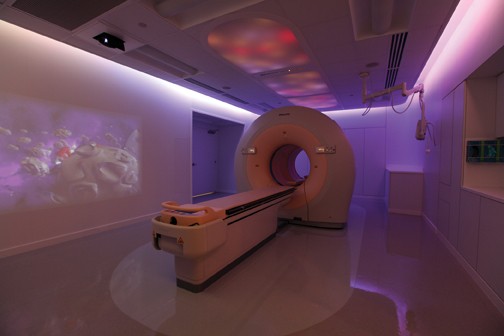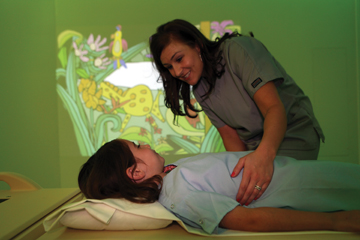Ambient Experience for PET-CT: Reducing patient anxiety, improving the clinical process
Images


Supplement to Applied Radiology December 2012, sponsored by Philips
Few words strike fear into a person like the words, “You have cancer.” An estimated 1.64 million people will hear those words this year as they receive a diagnosis of breast cancer, prostate cancer, head/neck cancer, or any one of the many other forms of the second-leading cause of death in the United States.1
As part of their treatment, many of these patients will undergo positron emission tomography and computed tomography (PET/CT) scanning, one of the most powerful and effective imaging technologies available to help radiation oncologists diagnose, stage, and monitor cancerous lesions and their response to treatment.
“PET scanning has revolutionized scanning for treatment of cancer,” said Bruce Cross, MD, citing head/neck cancer as just one example. “Before, we had assumed that if you had a large lymph node, you had to treat the entire lymph node. With PET scanning, you can distinguish which lymph nodes are involved and which ones are not. We have been able to tailor our treatment fields to [target] only the areas involved and to protect, for example, the salivary glands.”
As a radiation oncologist in the Sparks Health System in Fort Smith, AR, Dr. Cross said he uses PET/CT to help treat adults with “the whole gamut of cancers,” including lymphomas and cancers of the head and neck, lung, and breast.
Patient anxiety: A PET/CT imaging challenge
Yet getting patients’ anxiety under control is crucial to the success of PET/CT scanning, which requires injections of18F fluorodeoxyglucose (18F-FDG) and relies heavily on the patient to remain quiet and still for up to 90 minutes or more. That’s a challenging task for anyone, much less a patient dealing with the emotional turmoil accompanying a cancer diagnosis, said Dr. Cross.
“You are asking [patients] to wait while you inject them with radioactive material, and they are already pretty nervous to start with because they have cancer, and on top of that they have to be quiet. That is incredibly difficult for people to do,” he said.
“When you inject the patient with FDG, you want patients to be relaxed so they don’t produce false positives in the images, which may be caused by motion, either from humming, talking or just moving about,” he said, explaining that such motion can cause extra dye uptake and metabolization by the muscles, leading to false positive results.
Administering sedatives like diazepam to help patients relax is an option, but various studies have produced mixed results on their effectiveness, in addition to other drawbacks, such as the inability of outpatients to drive home and potential interactions with other drugs.2 Radiation oncologists like Dr. Cross use a variety of techniques to relax patients and enhance the clinical process.
The Ambient Experience solution
Ambient Experience is Philips’ strategy for creating a patient-friendly, soothing environment for those undergoing PET/CT imaging procedures. To calm nervous patients during radiopharmaceutical injection, the walls of the uptake room are bathed in a warm-colored glow, and patients are provided with a comfortable chair. Patients entering the exam room, meanwhile, can select from several different room themes by using a touchscreen tablet PC. The selected theme is reflected in immediate changes to the room environment, including colored lighting from a skylight and animated projected images accompanied by soothing music and other sounds.
An Ambient Experience suite is also designed to promote operational efficiency that, combined with more relaxed patients, helps improve patient compliance and streamlines PET/CT examinations by reducing patient anxiety.3
Audiovisual intervention: A sound solution
A recent study concluded that “audiovisual intervention” can help to reduce patient anxiety in the PET uptake room and reduce false positive 18F-FDG uptake in brown adipose tissue (BAT) “without the disadvantages associated with pharmacologic interventions.”2
“Throughout the stay in the uptake room, a significant decrease in overall anxiety was found, together with several other significant changes in patient physiology. In the cohort with audiovisual intervention, however, the decrease in patient anxiety was significantly larger. The cohort with intervention also showed significantly lower 18F-FDG uptake in BAT, but not in muscles,” the researchers reported.2
The results of the study of 101 patients were published in the June 2012 issue of the Journal of Nuclear Medicine Technology.* The study results are no surprise to Medhat M. Osman, MD, ScM, PhD, Associate Professor and Medical Director of the Division of Nuclear Medicine and PET/CT, Saint Louis University School of Medicine, St. Louis, Mo. “Strategies such as Ambient Experience can lead to improved patient management because calmer patients are better able to cooperate, which can impact many aspects of the clinical process,” Dr. Osman said. “And that means happier referring physicians.”
In the opinion of Dr. Cross, the value of Ambient Experience lies in delivering a more successful PET/CT examination because you have a calm, relaxed, and cooperative patient.
“The fact that we have provided [patients] with a distraction or entertainment … to take their mind off the radioactive agent is a really positive thing,” he said. “It gives them something else to focus on.”
He also said the tropical beach scenes are especially popular with his adult patients. “The beach, with palm trees and the ocean, is a classic mental getaway for adults. If the only thing available were cartoon characters, not many adults would want to see them. That’s why the choice [that the Ambient Experience] offers makes them very happy,” he said.
Dr. Cross said he is “convinced that we do a better job here” at Sparks in part because of Ambient Experience.
“I’ve been very impressed that Sparks went all out on with the Ambient Experience. I am convinced, from my 25 years of experience reading PET scans, that we do a better job here. How much of that is patient cooperation or the excellent algorithms in the technology is hard to tell, but I feel very secure that we’re doing a better job.”
*It is important to note that this study was performed with a prototype configuration that is not commercially available. Ambient Experience as a product/service has not been designed nor has it been approved by Philips to have capability to provide the effect described in the study.
References
- American Cancer Society. Cancer facts and figures 2012: Leading new cancer cases and deaths-2012 estimates. http://www.cancer.org/acs/groups/content/@epidemiologysurveilance/documents/document/acspc-032012.pdf. Last accessed Aug. 28, 2012.
- Vogel, Wouter V, Valdes Olmos Renato A, Tijs Tim JW, et al. “Intervention to lower anxiety of 18F-FDG PET/CT patients by use of audiovisual imagery during the uptake phase before imaging.” J Nucl Med Technol. 2012:40;1-7.
- Philips Website. Ambient Experience. PET/CT. http://www.healthcare.philips.com/us_en/products/ambient_experience/clinical_solutions/pet_ct/index.wpd. Accessed Aug. 28, 2012.
Citation
Ambient Experience for PET-CT: Reducing patient anxiety, improving the clinical process. Appl Radiol.
December 10, 2012